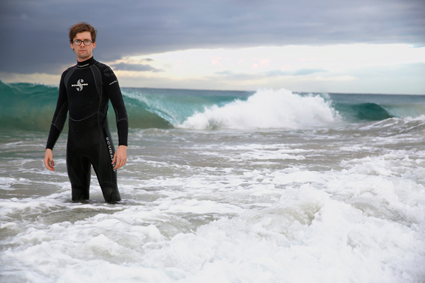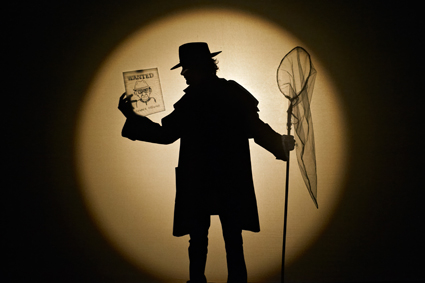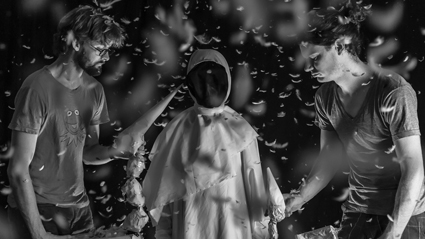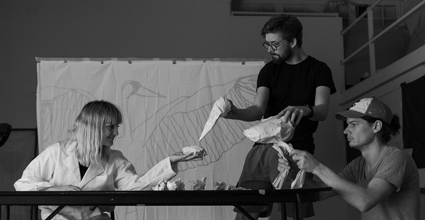Imaginings, puppets and saving cranes
Keith Gallasch, interview,Tim Watts, Falling Through Clouds

Tim Watts
photo Jamie Breen
Tim Watts
With an idiosyncratic take on puppetry melded with animation and shadow play, Perth-based Tim Watts has enjoyed considerable success in Australia and beyond with The Adventures of Alvin Sputnik: Deep Sea Explorer (2009) and It’s Dark Outside (2012 – see RT109 and RT113). Now he’s joined forces with fellow artists and long-term collaborators to create The Last Great Hunt, a group aiming at mutual creative support and touring. I spoke by phone with Watts when he took a break from sharing in the shaping of a new work, Falling Through Clouds, focused on the power of the imagination and the plight of severely diminished wildlife species.
After the relatively small scale of Alvin Sputnik and It’s Dark Outside is The Last Great Hunt a chance for you to work on a larger scale and with more collaborators?
The Last Great Hunt involves a collection of seven individuals whom I’ve worked with before, some of them many times. It’s really just a formalisation of an ensemble that was already kind of there and we thought, let’s join forces and really help each other to take all of our practices to the next step, as opposed to seeking companies to auspice us or arrange our tours for us. Falling Through Clouds is a bigger scale show, which is exciting. We work within our means often and this show has allowed us to work with slightly bigger means.
You mean in terms of the number of people on stage or the number of puppets or the extent of the animation?
I really try retain the sense of how creatively you have to problem-solve when you have only one person. We had to keep that in mind making It’s Dark Outside: although we had three pairs of hands we wanted to make a show that felt like five or 10 people are performing, the sense that there are more things happening than just three people [could possibly handle] on stage.

Tim Watts, It’s Dark Outside, Perth Theatre Company
photo Richard Jefferson
Tim Watts, It’s Dark Outside, Perth Theatre Company
What about the off-stage working of your projections and the shadow play in It’s Dark Outside?
With all of my shows the tech is operated by the performers and they do all of the shadow work and everything else. I do all the animation. We don’t have any stage managers or mechs and we bring all our lighting with us—we’ve designed our own system that’s both very tourable and heavily integrated into the show while we’re devising. At the moment we’re devising in the theatre where we’ll be performing in in five weeks, which is a privilege. We’re rehearsing in a complete blackout. Usually all the best stuff happens when we switch off the fluoros and use our own lights to create the scenes.
This portability and control must give the performers a good feeling of integrated possession of the work?
Yes, all the elements become equally important and integrated into the show. Sometimes you don’t realise how simple the puppetry or the acting needs to be in the actual scene when you have very precise lighting or the music is creating a particular mood. Then you only need to contribute a fraction in order to create a really simple yet sophisticated image or communicate a particular narrative. You can use lighting or animation in an inventive way to make a much more complete image. Even though we’re all performers at heart, we start considering all the other elements for communicating a particular story point or moment.
Do you begin with story or an image?
It’s really a mix. There’s not really one way that we devise. In terms of the ones where I’m leading the devising process we have a lot of showings. At the end of each week we invite an audience of usually not more than five to seven people to show some scenes. Even if we’re having lots of ideas we’re forced to make bite-sized chunks. Usually if you try to focus too much on story at that stage you don’t get anywhere in terms of making a scene because it becomes very difficult logistically to tell everything that you want when you have a short amount of time.
We film just about everything when we devise because we don’t really have a director sitting on the outside. All the performers are also the directors and creators. Every so often someone will sit out on scenes but we tend to film everything so we can look back over it at night and share it with the other collaborators, like the musicians.
The puppetry traditions you’re working with are fairly eclectic but nicely integrated. What’s your background in puppetry?
I was devising theatre shows and I started dabbling in puppetry because I’d seen it in other shows. We experimented and I started really enjoying it. I organised a puppetry workshop with Spare Parts Puppet Theatre in Fremantle—a really fantastic course for about a month, just learning the basics really. I did a couple of workshops around the world but none was as really influential as those few weeks with Spare Parts. The rest of it has really been basically learning on the job: you make a puppet and play with it in front of a mirror, in front of a camera and see how [it works out]. Almost every show we’ve done has had a different type of puppetry. There hasn’t been any formal training as such, just experimenting and whatever works works.
In Alvin, for example, you’ve focused very much on the hand.
That’s right. No training as such involved in that: just a matter of picking up a glove and a ball and mucking around in front of a mirror. That puppet actually came out of that same Spare Parts puppet workshop. We didn’t learn about a specific form of puppetry and that kind of epitomises my opinion of puppetry—I really love it but I’m not a purist. There are rules that we adhere to at times but I guess we’re less precious about them.
In It’s Dark Outside I liked the surprising changes in scale. Sometimes things are very large, other times quite small and, of course, the coup was having a human puppet at the centre. There seems to be something going on thematically in your works about the imagination, delusion and creativity if realised in very different ways in each. Puppetry lends itself to those kinds of themes, doesn’t it?
I guess ultimately it comes down to what I find interesting, what I feel. It’s all about the audience’s imaginative engagement and playing and manipulating and experimenting with it, whatever the form, through the imagination. Puppetry and animation are really fantastic at it. The audience has to actively pretend something dead is alive. The old man puppet in It’s Dark Outside, for instance, is nice but I don’t think it’s quite as successful as Alvin or the Dog in It’s Dark Outside. It’s much simpler to pretend that a little old man puppet is a little old man as opposed to a styrofoam ball on top of a hand. To some degree, the more work the audience has to do in terms of pretending that something is something else, the more potential it has of really sucking them into another world and feeling a bit more magical as an experience. I guess I’m continually fascinated by the human imagination and [our capacity for] delusion and how that affects our perception of the world. That keeps on cropping up in these different works.

Tim Watts, Adriane Daff, Chris Isaacs, Falling Through Clouds (development), The Great Last Hunt
photo Jamie Breen
Tim Watts, Adriane Daff, Chris Isaacs, Falling Through Clouds (development), The Great Last Hunt
On the one hand there’s delusion and on the other there’s creativity. Is it about reaching a kind of balance? In Falling Through Clouds you have a scientist who’s in love with flight but who can’t fly like a bird can.
Yes. I think there has to be an access point for an audience too. Stories that get a bit too weird or are all in someone’s mind are harder to engage with. There has to be a balance so an audience has a way in. We’re continually finding the balance with how much we don’t have to tell an audience, how open we can leave it without it becoming unsatisfying or too esoteric.
You’re not going for spectacle?
Well, I love a bit of spectacle but I want it to be rooted in some sort of universal truth or connection for an audience so that moment of spectacle is resonating from something more personal for them—so the spectacle is not purely surface but rather a grand expression of something that resonates.
Why the focus on a crane in particular in Falling Through Clouds? Looking at your work-in-progress video I wondered if there was an origami influence.
Actually, the initial inspiration for the show was flying and how much of an impossible dream it is. Then we heard a story about a conservation program to save whooping cranes on the brink of extinction. There were about 10 left in the world and there was a radical program to restore their numbers. It involved a very strange thing where they made the females lay loads and loads of eggs and then removed them from their chicks because they only take care of one at a time and it wasn’t going to be fast enough. This resulted in a very bizarre childhood for these new cranes: the scientists had to wear really spooky outfits with bird crane puppets on the end of their arms to show these new chicks how to eat, drink, mate and eventually fly. There were a lot of very interesting images in there about false motherhood, bizarre childhood and human intervention. That story has its own interesting trajectory which we’ve sort of taken inspiration from to tell one of our own. Our story is actually now pitched in a bit of a soft sci-fi area, in the future where there are no birds left at all and we’re bringing back a species.
Where did this original conservation program take place?
I believe it’s been running for 50 or 60 years. It’s in the US [and is run by IFC—the International Crane Foundation www.savingcranes.org. ICF has a 225-acre world headquarters near Baraboo, Wisconsin, “with a captive flock of approximately 100 cranes, including the only complete collection of all 15 species assembled.” Eds].

Adriane Daff, Tim Watts, Chris Isaacs, Falling Through Clouds (development), The Great Last Hunt
photo Jamie Breen
Adriane Daff, Tim Watts, Chris Isaacs, Falling Through Clouds (development), The Great Last Hunt
So will we see scientists teaching cranes to eat and drink?
Funny you should ask because these are the scenes we’ve been working on today. It’s hard to say what exactly will end up in the show. The thing that arrested us most about the story of these cranes in the US was that $100,000 put into the life of each bird and at the end of it all, when they let them out into the wild, they teach them to fly, but it’s currently unsustainable because the mother birds just get up and walk away [from the eggs]. It’s not a population that’s sustainable outside the laboratory—they’ve been unable to teach them how to be parents. As soon as they’re born they’re popped inside a cage with a stuffed swan with the head of a dead crane. And that’s their mother. And scientists in all-white outfits with their faces hidden and puppets on the end of their arms creating a bizarre childhood and a very peculiar relationship to their parents, which is ultimately false. Those are the elements of the story we find particularly interesting.
What’s the dynamic with the scientist then and her dream of flying?
At the core of it all there’s Mary the scientist and her imagination is very important to her. Every night she dreams of flying. Her goal is to restore birds to the world but beyond that there’s a subconscious goal to want to fly.
I suppose she’d like to take off with them.
Exactly. What we found when we were exploring flying as a life ambition was that it often represents something else like escape or freedom or that you’re in some sort of prison. We feel that for Mary it’s almost a bit of a mental prison. We’ve discovered an archetype of personality that comes from a child not having a very good relationship with the parents as in situations of controlled crying. The child learns that they’re not going to get their needs met by the primary caregiver so to some degree they shut themselves off from the world and become very solitary. As an adult this manifests as a hermit type character or someone who doesn’t engage very well with the world. Maybe they’re quite functional as an individual but they’re bad at sustaining relationships.I guess we’re using that archetype as a possible basis for Mary. Her dreams of flying are the one place she has to let down her walls and to feel free and soar above it all.
Who are you working with this time as principal collaborators?
Arielle Gray and Chris Isaacs whom I worked with on both Alvin and It’s Dark Outside and Adriane Daff, who I’ve worked with many times before. They’re co-devisors, performers, co-directors—all of it. It’s a very equal rehearsal process. I’m the initiating artist and the one who has to lead things a little bit from time to time but in terms of the show itself, it’s about all four of us coming together to make something. And then besides that we also have Ash Gibson Greig, the composer who’s making us a beautiful score.
Is Falling Through Clouds designed to suit young and adult audiences simultaneously as in your previous work?
We’re unsure at the moment. Right now we’re saying 15+. I think it might be a bit more adult than Alvin and probably similar to It’s Dark Outside with some adult themes and some dark subject matter.
PICA & The Last Great Hunt, Falling Through Clouds, PICA, Perth Institute of Contemporary Arts, 22 Sept–11 Oct
RealTime issue #122 Aug-Sept 2014 pg. web






